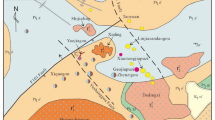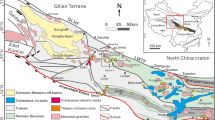Abstract
Widely-distributed lamprophyres in the Laowangzhai gold deposit were associated closely with gold ores. Phlogopite40Ar/39Ar dating suggests that the emplacement age of lamprophyric magma ranges from (30.8±0.4) to (34.3±0.2) Ma, and gold mineralization took place at (26.4±0.2) Ma. PGE geochemical tracing indicates that gold in the gold deposit did not come from the primitive lamprophyric magma. The tempo-spatial paragenesis between lamprophyres and mesothermal gold deposits along the Jinsha-Red River belt may be attributed to the fact that they formed in the same tectonic setting.
Similar content being viewed by others
References
He, W. J., Characteristics of the lamprophyres and their relations to gold mineralization in the Zhenyuan gold deposit field, Yunnan Geology (in Chinese), 1993, 12(2): 148–158.
Huang, Z. L., Liu, C. Q., Zhu, C. M., The origin of lamprophyres in the Laowangzhai gold filed, Yunnan Province and Their Relations with Gold Mineralization (in Chinese), Beijing: Geological Publishing House, 1999, 1–251.
Bi, X. W., Hu, R. Z., He, M. Y., ESR ages and their geologic significance in the Ailao Shan gold deposit belt, Chinese Science Bulletin, 1996, 41(14): 1301–1303.
Hu, R. Z., Bi, X. W., He, M. Y., Mineralizer constraining the gold mineralization in the Ailao Shan gold-deposit belt, Science in China, Series D, 1998, 28(Suppl.): 24–30.
Zhang, Z. L., Zhang, S. F., Yuan, H. H. et al., An isotope geology and origin study of the Jinchang gold deposit, Mojiang, Yunnan, Journal of Chengdu College Geology (in Chinese), 1987, 14(4): 29–41.
Geyh, M. A., Schleicher, H., Absolute Age Determination: Physical and Chemical Dating Methods and Their Application, Berlin: Springer-Verlag, 1990, 272–282.
Huang, Z. L., Zhu, C. M., Xiao, H. Y. et al., Can a lamprophyric magma carry gold up? The evidence from a high-T and high-P experiment. Chinese Science Bulletin, 1999, 44(12): 1331–1334.
Harrison, T. M., Chen, W. J., Leloup, P. H., et al., An early Miocene transition in deformation regime within the Red River fault zone, Yunnan, and its significance for Indo-Asian tectonics, Journal of Geophysical Research (in Chinese), 1992, 97: 7159–7182.
Gregoire, D. C., Determination of platinum, palladium, ruthenium and iridium geological materials by inductively coupled plasma mass spectrometry with sample introduction by electrothermal vaporization. Journal of Analytical Atomic Spectrometry, 1988, 3: 309–314.
Qi, L., Deng, H. L., Hu, J., Determination of precious metal elements in geological samples by isotope dilute inductively coupled plasma mass spectrometry, Yunnan Chemical Engineering (in Chinese), 1998, (Suppl.): 94–96.
Liu, Y., Liu, H. C., Li, X. H., Simultaneous and precise determination of 40 trace elements in rock samples using ICP-MS, Geochimica, 1996, 25(6): 552–558.
Naldrett, A. J., Duke, J. M., Platinum metals in magmatic sulfide ores, Science, 1980, 208: 1417–1424.
Sun, S. S., Chemical composition and origin of the earth’s primitive mantle, Geochimica et Cosmochimica Acta, 1982, 46: 176–192.
Brugmann, G. E., Arndt, N. T., Hoffmann, A. W. et al., Nobel metal abundances in komatiite suites from Alexo, Ontario and Gorgona Island, Colombia, Geochimica et Cosmochimica Acta, 1987, 51: 2159–2169.
Rock, N. S. M., Groves, D. I., Can lamprophyres resolve the genetic controversy over mesothermal gold deposit? Geology, 1988, 16: 538–541.
Rock, N. S. M., Groves, D. I., Perring, C. S. et al., Gold, lamprophyre and porphyries: what does their association mean? Economic Geology, 1989, 6: 609–625.
Wyman, D. A., Kerrich, R., Archean shoshonitic lamprophyres associated with superior province gold deposits: Distribution, tectonic setting, noble metal abundances, and significance for gold mineralization, Economic Geology, 1989, 6: 651–667.
Sun, S. S., Wallace, D. A., Hoatson, D. M. et al., Use of geochemistry as a guide to platinum group element potential of mafic-ultramafic rocks: examples from the west Pilbara and Halls Creek mobile zone, western Australia, Precambrian Research, 1991, 50: 1–35.
Wang, J. H., Yin, A., Harrison, T. M. et al., A tectonic model for Cenozoic igneous activities in the eastern Indo-Asian collision zone, Earth and Planetary Science Letters, 2001, 188: 123–133.
Author information
Authors and Affiliations
Corresponding author
Rights and permissions
About this article
Cite this article
Wang, J., Qi, L., Yin, A. et al. Emplacement age and PGE geochemistry of lamprophyres in the Laowangzhai gold deposit, Yunnan, SW China. Sci. China Ser. D-Earth Sci. 44 (Suppl 1), 146–154 (2001). https://doi.org/10.1007/BF02911982
Received:
Issue Date:
DOI: https://doi.org/10.1007/BF02911982




